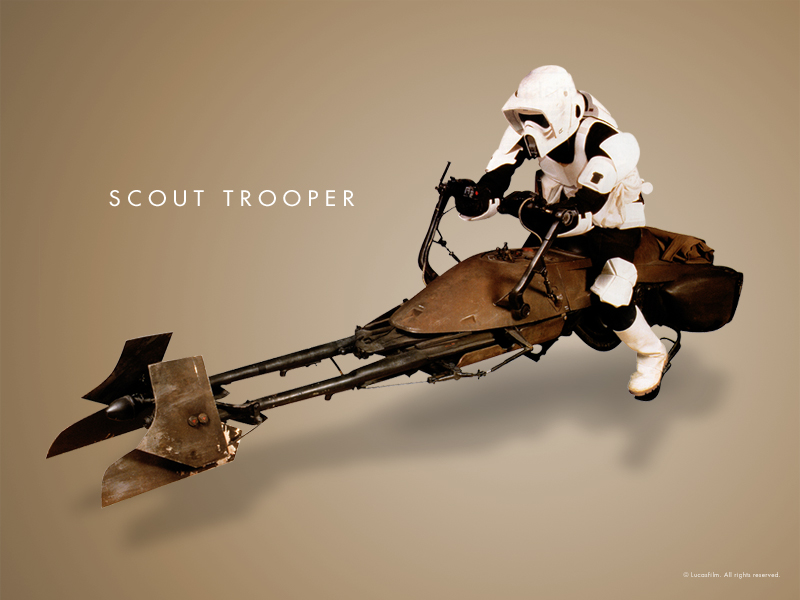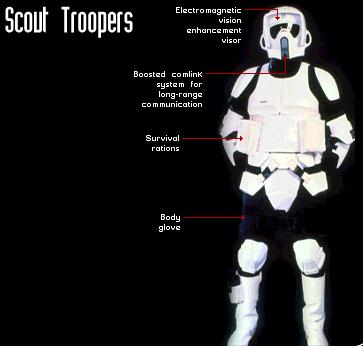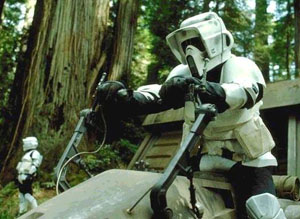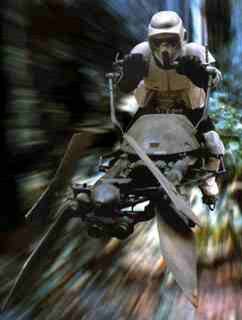
MEMBER ACCOUNT
EMPEROR'S HAMMER
OPERATIONS
- Battle Center
- Patch Archive
- Competition Center
- Combat Center
- Imperial University
- Mission Creation Center
- Fiction Center
DATA CENTER
- Killboards
- Squadron Battleboards
- Pilot Statistics and Ranks
- Medal Board
- Uniforms
- Roster Tools
- Complete Craft List
COMMUNICATIONS
EH SUBGROUPS
REFERENCE & MANUALS
- Encyclopaedia Imperia Wiki
- TIE Corps Pilot Manual
- SO Dark Side Compendium
- COO Manual
- Tactical Manual
- Fleet Manual
- Training Manual
- System Manual
- Fleet Order of Battle
EH POLICIES & INFO
UTC
Scout Trooper Course Notes

Introduction
Unlike other stormtroopers, scout troopers are equipped to perform missions far from re-supply by Imperial forces. As such, their personal transports are stocked with a survival kit and extra gear. His backpack has a portable power unit. They are also lightly armoured, allowing them to move quickly through most areas. They carry food supplies, micro profiles and specialised gear designed for specific mission profiles and terrain. They are trained to operate independently, but travel in squads, or lances, consisting of four soldiers led by a sergeant commander. While travelling at dangerous velocities on their Speeder bikes, they wear specialized helmets equipped with built-in macrobinoclular viewplates and sensor arrays. These devices feed into a small computer capable of instantaneously analyzing the surrounding terrain to aid the trooper in navigation. The Storm Commandos are an elite and highly trained unit of scout troopers who wear black scout armor and are highly trained in every aspect of killing the enemy.
Like other elite units, Imperial Scouts are usually assigned to garrison posts. At a typical Imperial Garrison base, Scout Speeder Bike squadrons perform reconnaissance and patrol missions in cooperation with AT-ST walkers. Imperial doctrine states that garrisons should remain active and aggressive, performing continuous patrols to establish a tangible presence, even on "pacified" worlds. Scouts may also be used for reconaissance missions on 'unpacified' worlds. For example, an Imperial Scout ship may find a rebel stronghold on a planet. Instead of sending a fullscale invasion force to squash the stronghold, a Scout team may be sent in to get accurate information on the base. The Scout team would gather all needed information, and would send it back to the main Stormtrooper force so they may get a tactical picture of the situation.
A Scout also will go wherever he is ordered to go. It is not the individual trooper's job to question higher authority on missions. The only fear a Scout has is that of failing his Emperor, death is nothing to him. Due to the secrecy of some missions, some Scouts may never really know what planet they are on, or even what system they are in. Basically, whenever Imperial High Command needs a ground recon of a planet, they will send Scouts, because they are the best at reconaissance.
A Scout troop consists of 40 men and 40 bikes, as well as 10 service technicians to keep the bikes in good repair. Each troop contains four squadrons of 10 bikes each. In Addition to the 40 scouts, one lieutenant and four sergeants command the unit.
The Aratech 74-Z speeder bike is the core piece of equipment of an Imperial Scout Trooper. This small, one-man repulsorlift vehicle can attain speeds in excess of 200 KM/H (125 MPH). A Scout Trooper controls the explosively quick bike by manipulating handle bar and foot pedal controls which move four small directional steering vanes on twin outriggers that extend from the front of the bike. Elevation and direction are determined through the use of two handgrips, located at shoulder level in front of the pilot. Speed controls built into rocker-pivoted foot pads provide maximum acceleration. The saddle section contains levers and knobs used for parking, weaponry, and communication. The 74-Z has a self-charging energy source that allows a scout to explore and patrol far from base without worrying about fuel capacity. Speeder bikes are armed with a small blaster cannon and lightly armored for additional protection.

Because speeder bikes require sensitive handling, Imperial Scouts wear highly specialized light-weight armor. It's more comfortable and maneuverable than the bulkier standard-issue Storm Trooper armor. White body armor is attached to a black body glove, but some of the heavier armor plating has been replaced with lighter, more flexible padding. A breastplate with connecting shoulder, elbow, and forearm pieces, a wide utility belt, and knee-to-toe armor complete the uniform.
The helmet comes equipped with a built-in macrobinocular viewplate and sensor array that allows a scout to scan a 180-degree area while flying close to the ground. A miniature computer analyzes movement, stationary objects, and other details, quickly, relaying the information to the scout across the top of his helmet's viewplate. Without these sensors, even the best bikers would be hard pressed to maneuver and steer through forests, canyons, and other terrain while moving so fast. The helmet also contains a built-in breathing apparatus to protect the scout at high speeds, and computers that map the area they explore, producing a continuous record of the scouts mission.
Scouts carry a small automatic blaster rifle and pistol, as well as standard flares and concussion grenades, but rarely engage in heavy combat. If they run into strong enemy forces, they are directed to leave the area at once, calling in the location, so that storm trooper units can move in and deal with the situation. Due to the speed and secrecy of a Scout, some units have been cross-trained with Imperial Sniper squads, allowing the Scouts to be used on assasination missions in unexplored enemy areas.

Specifications
The Scout Squad:
- Trains, equips, and controls the employment of four scout teams.
- Infiltrates the objective area by speeder bike, or foot.
- Remains undetected in the objective area for up to 5 days.
- Performs reconnaissance operations.
- Performs demolition target analysis.
- Operates speeder bikes.
- Emplaces and monitors unattended ground sensors.
- Employs night image enhancement devices.
- Employs photographic equipment.
- Emplaces electronic target acquisition/designation devices.
- Collects specific combat information to satisfy mission essential elements of information and priority information requirements. (PIR)
- Reports information using secure, long-range communication equipment.
- Performs drop zone and landing selection, marking, and reception duties.
- Escapes and evades enemy areas undetected.
- Reports objective area weather conditions.
Stormtrooper Scout units are special light infantry organizations.
Their primary missions involve rapid deployment to any location, on any world, prepared to fight on any terrain and in any climate condition. Scouts must be able to arrive at their objective area by shuttle, tracked vehicle, speeder, amphibious means, or by foot.
Training
TRAINING IS EVERYTHING AND EVERYTHING IS TRAINING.
Everything Scouts do should prepare them to perform their jobs in combat. Scout units train in accordance with the Platoon training management system with a concentration on the basics and an emphasis on live-fire training. As a Scout develops individual job proficiency, he is undergoing training. Scouts must have effective training to ensure:
- Combat readiness
- That the Scout can perform the task at hand and valuable resources are not wasted.
- Train to standard--not time. Ensure that training objective = training = evaluation.
- Develop and maintain a climate of discipline, esprit, and cohesion to ensure that the full potential of individual Scouts and units are realized.
- Develop and maintain a high level of individual physical fitness through strength training, running, road marches, aerobics, mass games, competitive athletics, and job-related fitness training.
- Develop a unit atmosphere of quick reaction under stress, which encourages and rewards individual initiative, innovation, and ingenuity while channeling these efforts toward accomplishment of the unit mission in accordance with the commander's intent.
Training is the responsibility of all members of the chain of command. The NCO leader or first-line supervisor is responsible to his commander for the conduct of individual proficiency and small unit collective task training of the Scouts under his control. This training leads to mission capability. The officer is responsible for the planning of individual training in his unit, and he is charged to direct and conduct collective training, which leads to mission accomplishment.
Commanders must have a management model for training. They must ensure they set objectives for all troopers. If a soldier does not have an objective, he is lost. A soldier with a purpose and a mission will in most cases get it done with no problem. The Commander must also provide the resources to complete the mission, without resources even the most hard-willed trooper will not succeed. Many things contribute to training, it is not an easy task, but it is one that must be done. A Commander must coach his subordinates on what they do, measure their results, and then provide them with feedback so they may better their performance, and in turn, better their unit's overall performance.
Deception
There are always plans to deny the enemy knowledge of the Scout unit's insertion, or to deceive him as to the location or intent of the operation. Feints, false insertions, and other deception operations (such as diversionary airstrikes, or ground attacks) as well of the use of multiple routes and means of insertion, electronic countermeasures, and false transmissions and activities, all contribute to Scout deception plans.
Specific deception techniques that may be used include:
- Multiple airdrops, water landings, or both. This precludes the entire force from becoming engaged at the same time and place, if detected.
- Dispersion of insertion craft (air or water) both in time and location
- Leaks of false information and false messages to deceive the enemy.
- False insertions or radio traffic to disguise actual insertions.
- Increased reconaissance flights, either by manned aircraft or remotely piloted vehicles, over false targets to further mislead the enemy.
Movement
 Moving for Scouts is difficult. While regular Stormtroopers rely on blitzkreig (lightning warfare) techniques, Scout troopers rely on stealth and speed. Unfortunately for Scouts, their speeder bikes are not the quietest of machines, and modifications for sound-dampening are always being made. Scouts must utilize cover at all times, and when moving, try to use concealed routes. The old adage always comes into mind, 'Out of sight, out of mind.'
Moving for Scouts is difficult. While regular Stormtroopers rely on blitzkreig (lightning warfare) techniques, Scout troopers rely on stealth and speed. Unfortunately for Scouts, their speeder bikes are not the quietest of machines, and modifications for sound-dampening are always being made. Scouts must utilize cover at all times, and when moving, try to use concealed routes. The old adage always comes into mind, 'Out of sight, out of mind.'
Unfortunately for Scouts, the planet they are scouting may know they are there, so Scouts always have to avoid likely ambush sites, or other danger areas, such as hidden weapon emplacements, or booby traps.
Scouts must also practice camouflage, noise and light discipline at all times. For example, if a Scout gets off his bike to look at something, he should throw cover over it to break its silhouette. Also, due to the danger of scouting missions, security of the team is paramount to everything. During downtime in the field, Scouts maintain a 50/50 security perimeter, which means having half of your force awake on guard, while the other half sleeps.
Engaging the enemy for Scouts can be deadly business, so Scouts are instructed not to engage the enemy., unless an ensured victory is guaranteed. Scouts are in no way armed to deal with even a small enemy force. If enemy contact is initiated however, Scouts are to make contact with the smallest element possible. In the event a mission is compromised, the Scout team will immediately evacuate the immediate area. Upon evacuating, the Scouts will then try to still accomplish the mission by another way. The mission always comes first. Scouts may be used to draw an enemy force away from a main objective, so the regular Stormtrooper Force can come in and take over.
Limitations
Limitations of the Scout Team include:
- Mobility is normally restricted to speeder bike movement in the area of operations.
- Use of radio and other active electronic or optical devices make the teams vulnerable to enemy detection.
- All supplies and equipment needed or anticipated by the team must be carried on the initial insertion, since resupply increases the probability of detection by the enemy.
- Conducting insertion and extraction operations deep in enemy held territory are difficult due to the requirements for secrecy, timeliness, security, and accuracy of location.
- Medical treatment of team casualties is limited to individual first aid. Casualty evacuation is difficult unless linkup with the main Stormtrooper force has been achieved.